Early Revolts against British Rule in Tamil Nadu - Palayakkarars’ Revolt 1755-1801 | 10th Social Science : History : Chapter 6 : Early Revolts against British Rule in Tamil Nadu
Chapter: 10th Social Science : History : Chapter 6 : Early Revolts against British Rule in Tamil Nadu
Palayakkarars’ Revolt 1755-1801
Palayakkarars’ Revolt 1755-1801
(a) Revolt of Puli Thevar 1755–1767
March 1755
Mahfuzkhan (brother of the Nawab of Arcot) was sent with a contingent of the Company
army under Colonel Heron to Tirunelveli. Madurai easily fell into their hands.
Thereafter Colonel Heron was urged to deal with Puli Thevar as he continued to
defy the authority of the Company. Puli Thevar wielded much influence over the
western palyakkarars. For want of cannon and of supplies and pay to soldiers,
Colonel Heron abandoned the plan and retired to Madurai. Heron was recalled and
dismissed from service.
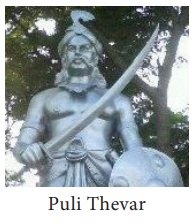
Confederacy and Alliance with Enemies of the British
Three
Pathan officers, Nawab Chanda Sahib’s agents, named Mianah, Mudimiah and Nabikhan
Kattak commanded the Madurai and Tirunelveli regions. They supported the Tamil
playakkarars against Arcot Nawab Mohamed Ali. Puli Thevar had established close
relationships with them. Puli Thevar also formed a confederacy of the
Palayakkars to fight the British. With the exception of the Palayakkarars of
Sivagiri, all other Maravar Palayams supported him. Ettayapuram and
Panchalamkurichi also did not join this confederacy. Further, the English
succeeded in getting the support of the rajas of Ramanathapuram and Pudukottai.
Puli Thevar tried to get the support of Hyder Ali of Mysore and the French.
Hyder Ali could not help Puli Thevar as he was already locked in a serious
conflict with the Marathas.
Kalakadu Battle
The Nawab
sent an additional contingent of sepoys to Mahfuzkhan and the reinforced army
proceeded to Tirunelveli. Besides the 1000 sepoys of the Company, Mahfuzkhan
received 600 more sent by the Nawab. He also had the support of cavalry and
foot soldiers from the Carnatic. Before Mahfuzkhan could station his troops
near Kalakadu, 2000 soldiers from Travancore joined the forces of Puli Thevar.
In the battle at Kalakadu, Mahfuzkhan's troops were routed.
Yusuf Khan and Puli Thevar
The
organized resistance of the palayakkarars under Puli Thevar gave an opportunity
to the English to interfere directly in the affairs of Tirunelveli. Aided by
the Raja of Travancore, from 1756 to 1763, the palyakkarars of Tirunelveli led
by Puli Thevar were in a constant state of rebellion against the Nawab’s
authority. Yusuf Khan (also known as Khan Sahib or, before his conversion to
Islam, Marudhanayagam) who had been sent by the Company was not prepared to
attack Puli Thevar unless the big guns and ammunition from Tiruchirappalli
arrived. As the English were at war with the French, as well as with Hyder Ali
and Marathas, the artillery arrived only in September 1760. Yusuf Khan began to
batter the Nerkattumseval fort and this attack continued for about two months.
On 16 May 1761 Puli Thevar’s three major forts (Nerkattumseval, Vasudevanallur
and Panayur) came under the control of Yusuf Khan.
In the
meantime, after taking Pondicherry the English had eliminated the French from
the picture. As a result of this the unity of palyakkarars began to break up as
French support was not forthcoming. Travancore, Seithur, Uthumalai and Surandai
switched their loyalty to the opposite camp. Yusuf Khan who was negotiating
with the palayakkarars, without informing the Company administration, was
charged with treachery and hanged in 1764.
Fall of Puli Thevar
After the
death of Khan Sahib, Puli Thevar returned from exile and recaptured
Nerkattumseval in 1764. However, he was defeated by Captain Campbell in 1767.
Puli Thevar escaped and died in exile.
Ondiveeran: Ondiveeran led one of the army units of Puli Thevar. Fighting by the side of Puli Thevar, he
caused much damage to the Company’s army. According to oral tradition, in one
battle, Ondiveeran’s hand was chopped off and Puli Thevar was saddened. But
Ondiveeran said it was a reward for his penetration into enemy’s fort causing
many heads to roll.
(b) Velunachiyar (1730–1796)
Born in
1730 to the Raja Sellamuthu Sethupathy of Ramanathapuram, Velunachiyar was the
only daughter of this royal family. The king had no male heir. The royal family
brought up the princess Velunachiyar, training her in martial arts like valari, stick fighting and to wield
weapons. She was also adept in horse
riding and archery, apart from her proficiency in English, French and Urdu.
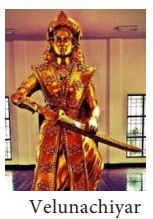
In At the
age of 16, Velunachiyar was married to Muthu Vadugar, the Raja of Sivagangai,
and had a daughter by name Vellachinachiar. In 1772, the Nawab of Arcot and the
Company troops under the command of Lt. Col. Bon Jour stormed the Kalaiyar
Kovil Palace. In the ensuing battle Muthu Vadugar was killed. Velunachiyar
escaped with her daughter and lived under
the protection of Gopala Nayak at Virupachi near Dindigul for eight years.
Gopala Nayak, the
Palayakkarar of Virupachi: Gopala Nayak spearheaded the famous Dindigul League, which was
formed with Lakshmi Nayak of Manaparai and Poojai Nayak of Devadanapatti. He
drew inspiration from Tipu Sultan who sent a deputation to show his
camaraderie. He led the resistance against the British from Coimbatore and
later joined Oomaidurai, Kattabomman’s brother. He put up a fierce fight at
Aanamalai hills where the local peasants gave him full support. But Gopala
Nayak was overpowered by the British forces in 1801.
Duringherperiodinhiding,Velunachiyar
organised an army and succeeded in securing an alliance with not only Gopala
Nayakar but Hyder Ali as well. Dalavay (military chief) Thandavarayanar wrote a
letter to Sultan Hyder Ali on behalf of Velunachiyar asking for 5000 infantry
and 5000 cavalry to defeat the English. Velunachiyar explained in detail in
Urdu all the problems she had with East India Company. She conveyed her strong
determination to fight the English. Impressed by her courage, Hyder Ali ordered
his Commandant Syed in Dindigul fort to provide the required military
assistance.
Velunachiyar
employed agents for gathering intelligence to find where the British had stored
their ammunition. With military assistance from Gopala Nayak and Hyder Ali she
recaptured Sivagangai. She was crowned as Queen with the help of Marudhu
brothers. She was the first female ruler or queen to resist the British
colonial power in India.
Kuyili, a faithful friend of Velunachiyar, is said to have led
the unit of women soldiers named after Udaiyaal. Udaiyaal was a shepherd girl
who was killed for not divulging information on Kuyili. Kuyili is said to have
walked into the British arsenal (1780) after setting herself on fire, thus
destroying all the ammunition.
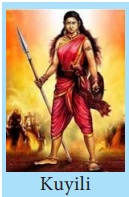
(c) Rebellion of Veerapandya Kattabomman 1790-1799
Veerapandya
Kattabomman became the Palayakkarar of Panchalamkurichi at the age of thirty on
the death of his father, Jagavira Pandya Kattabomman.
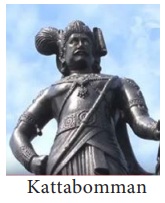
The Company’s
administrators, James London and Colin Jackson, had considered him a man of
peaceful disposition. However, soon several events led to conflicts between
Veerapandya Kattabomman and the East India Company. The Nawab, under the
provisions of a treaty signed in 1781, had assigned the revenue of the Carnatic
to the Company to be entirely under their management and control during the war
with Mysore Sultan. One-sixth of the revenue was to be allowed to meet the
expenses of Nawab and his family. The Company had thus gained the right to
collect taxes from Panchalamkurichi. The Company appointed its Collectors to
collect taxes from all the palayams. The Collectors humiliated the
palayakkarars and adopted force to collect the taxes. This was the bone of
contention between the English and Kattabomman.
Confrontation with Jackson
The land
revenue arrear from Kattabomman was 3310 pagodas in 1798. Collector Jackson, an
arrogant English officer, wanted to send an army to collect the revenue dues
but the Madras Government did not give him permission. On 18 August 1798, he
ordered Kattabomman to meet him in Ramanathapuram. But Kattbomman’s attempts to
meet him in between proved futile, as Jackson refused to give him audience both
in Courtallam and Srivilliputhur. At last, an interview was granted and
Kattabomman met Jackson in Ramanathapurm on 19 September 1798. It is said that
Kattabomman had to stand for three hours before the haughty Collector Jackson.
Sensing danger, Kattabomman tried to escape, along with his minister
Sivasubramanianar. Oomaithurai suddenly entered the fort with his men and
helped the escape of Kattabomman. At the gate of the Ramanathapuram fort there
was a clash, in which some people including Lieutenant Clarke were killed.
Sivasubramanianar was taken prisoner.
Appearance before Madras Council
On his
return to Panchalamkurichi, Kattabomman represented to the Madras Council about
how he was ill-treated by the collector Jackson. The Council asked Kattabomman
to appear before a committee with William Brown, William Oram and John
Casamajor as members. Meanwhile, Governor Edward Clive, ordered the release of
Sivasubramanianar and the suspension of the Collector Jackson. Kattabomman
appeared before the Committee that sat on 15 December 1798 and reported on what
transpired in Ramanathapuram. The Committee found Kattabomman was not guilty.
Jackson was dismissed from service and a new Collector S.R. Lushington
appointed. Kattabomman cleared almost all the revenue arrears leaving only a
balance of 1080 pagodas.
Kattabomman and the Confederacy of Palayakkarars
In the
meantime, Marudhu Pandiyar of Sivagangai formed the South Indian Confederacy of
rebels against the British, with the neighbouring palayakkars like Gopala Nayak
of Dindigul and Yadul Nayak of Aanamalai. Marudhu Pandiyar acted as its leader.
The Tiruchirappalli Proclamation had been made. Kattabomman was interested in
this confederacy. Collector Lushington prevented Kattabomman from meeting the
Marudhu Brothers. But Marudhu Brothers and Kattabomman jointly decided on a
confrontation with the English. Kattabomman tried to influence Sivagiri
Palayakkarars, who refused to join. Kattabomman advanced towards Sivagiri. But
the Palayakkarars of Sivagiri was a tributary to the Company. So the Company
considered the expedition of Kattabomman as a challenge to their authority. The
Company ordered the army to march on to Tirunelveli.
The Siege of Panchalamkurichi
In May
1799, Lord Wellesley issued orders from Madras for the advance of forces from
Tiruchirappalli, Thanjavur and Madurai to Tirunelveli. Major Bannerman
commanded the troops. The Travancore troops too joined the British. On 1
September 1799, an ultimatum was served on Kattabomman to surrender.
Kattabomman’s “evasive reply” prompted Bannerman to attack his fort. Bannerman
moved his entire army to Panchalamkurichi on 5 September. They cut off all the
communications to the fort. Bannerman deputed Ramalinganar to convey a message
asking Kattabomman to surrender. Kattabomman refused. Ramalinganar gathered all
the secrets of the Fort, and on the basis of his report, Bannerman decided the
strategy of the operation. In a clash at Kallarpatti, Sivasubramanianar was
taken a prisoner.

Execution of Kattabomman
Kattabomman
escaped to Pudukottai. The British put a prize on his head. Betrayed by the
rajas of Ettayapuram and Pudukottai Kattabomman was finally captured.
Sivasubramanianar was executed at Nagalapuram on the 13 September. Bannerman
made a mockery of a trial for Kattabomman in front of the palayakarars on 16
October. During the trial Kattabomman bravely admitted all the charges levelled
against him. Kattabomman was hanged from a tamarind tree in the old fort of
Kayathar, close to Tirunelveli, in front of the fellow Palayakkars. Thus ended
the life of the celebrated Palayakkarars of Panchalamkurichi. Many folk ballads
on Kattabomman helped keep his memory alive among the people.
(d) The Marudhu Brothers
Periya
Marudhu or Vella Marudhu (1748–1801) and his younger brother Chinna Marudhu
(1753-1801) were able generals of Muthu Vadugar of Sivagangai. After Muthu
Vadugar's death in the Kalaiyar Kovil battle Marudhu brothers assisted in
restoring the throne to Velunachiyar. In the last years of the eighteenth
century Marudhu Brothers organised resistance against the British. After the
death of Kattabomman, they worked along with his brother Oomathurai. They plundered
the granaries of the Nawab and caused damage and destruction to Company troops.
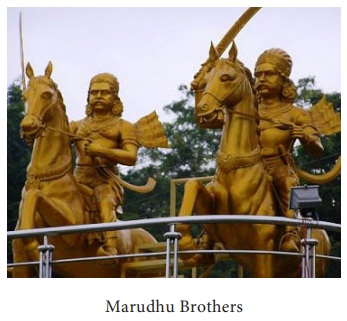
Rebellion of Marudhu Brothers (1800–1801)
Despite
the suppression of Kattabomman’s revolt in 1799, rebellion broke out again in
1800. In the British records it is referred to as the Second Palayakarar War.
It was directed by a confederacy consisting of Marudhu Pandyan of Sivagangai,
Gopala Nayak of Dindugal, Kerala Verma of Malabar and Krishnappa Nayak and
Dhoondaji of Mysore. In April 1800 they meet at Virupachi and decided to
organise an uprising against the Company. The uprising, which broke out in
Coimbatore in June 1800, soon spread to Ramanathapuram and Madurai. The Company
got wind of it and declared war on Krishnappa Nayak of Mysore, Kerala Varma of
Malabar and others. The Palayakars of Coimbatore, Sathyamangalam and Tarapuram
were caught and hanged.
In
February 1801 the two brothers of Kattabomman, Oomathurai and Sevathaiah,
escaped from the Palayamkottai prison to Kamudhi, from where Chinna Marudhu
took them to Siruvayal his capital. The fort at Panchalamkurichi was
reconstructed in record time. The British troops under Colin Macaulay retook
the fort in April and the Marudhu brothers sought shelter in Sivagangai. The
English demanded that the Marudhu Pandyars hand over the fugitives (Oomathurai
and Sevathaiah). But they refused. Colonel Agnew and Colonel Innes marched on
Sivagangai. In June 1801 Marudhu Pandyars issued a proclamation of Independence
which is called Tiruchirappalli Proclamation.
Proclamation of 1801
The
Proclamation of 1801 was an early call to the Indians to unite against the
British, cutting across region, caste, creed and religion. The proclamation was
pasted on the walls of the Nawab’s palace in Tiruchirappalli fort and on the
walls of the Srirangam temple. Many palayakkars of Tamil country rallied
together to fight against the English. Chinna Marudhu collected nearly 20,000
men to challenge the English army. British reinforcements were rushed from
Bengal, Ceylon and Malaya. The rajas of Pudukkottai, Ettayapuram and Thanjavur
stood by the British. Divide and rule policy followed by the English spilt the
forces of the palayakkarars soon.
Fall of Sivagangai
In May
1801, the English attacked the rebels in Thanjavur and Tiruchirappalli. The
rebels went to Piranmalai and Kalayarkoil. They were again defeated by the
forces of the English. In the end the superior military strength and the able
commanders of the English Company prevailed. The rebellion failed and
Sivagangai was annexed in 1801. The Marudhu brothers were executed in the Fort
of Tirupathur near Ramanathapuram on 24 October 1801. Oomathurai and Sevathaiah
were captured and beheaded at Panchalamkurichi on 16 November 1801.
Seventy-three rebels were exiled to Penang in Malaya. Though the palayakkarars
fell to the English, their exploits and sacrifices inspired later generations.
Thus the rebellion of Marudhu brothers, which is called South Indian Rebellion,
is a landmark event in the history of Tamil Nadu.
Carnatic Treaty, 1801
The
suppression of the Palayakkarars rebellions of 1799 and 1800–1801 resulted in
the liquidation of all the local chieftains of Tamilnadu. Under the terms of
the Carnatic Treaty of 31 July 1801, the British assumed direct control over
Tamilagam and the Palayakarar system came to an end with the demolition of all
forts and disbandment of their army.
(e) Dheeran Chinnamalai (1756–1805)
Born as
Theerthagiri in 1756, Dheeran was well trained in silambu, archery, horse
riding and modern warfare. He was involved in resolving family and land disputes
in Kongu region. As this region was under the control of the Mysore Sultan, tax
was collected by Tipu’s Diwan Mohammed Ali. Once, when the Diwan was returning
to Mysore with the tax money, Theerthagiri blocked his way and confiscated all
the tax money. He let Mohammed Ali go by instructing him to tell his Sultan
that “Chinnamalai”, who is between Sivamalai and Chennimalai, was the one who
took away taxes. Thus he gained the name “Dheeran Chinnamalai”. The offended Diwan
sent a contingent to attack Chinnamalai and both the forces met and fought at
the Noyyal river bed. Chinnamalai emerged victorious.
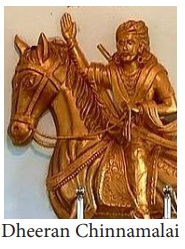
After
Tipu’s death Dheeran Chinnamalai built a fort and fought the British without
leaving the place. Hence the place is called Odanilai. He launched guerrilla attacks and evaded capture. Finally the English captured him and his brothers
and kept them in prison in Sankagiri. When they were asked to accept the rule
of the British, they refused. So they were hanged at the top of the Sankagiri
Fort on 31 July 1805.

Related Topics